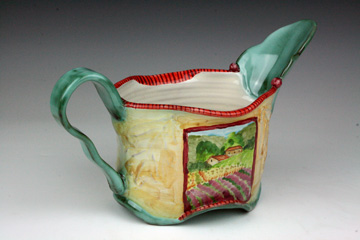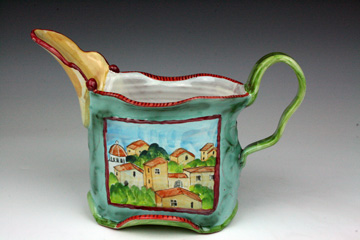"What do you do, stay in the studio until you make a whole bunch, then go out on the road and sell it?"
Well, kinda. Yes and no. What he was really expressing is the notion most people seem to have that I can just decide what shows I'd like to do, then drive there on the dates the show is open and set up my booth to sell.
So, if you've wondered, here's how the system works for artists.
There are a few very good shows, some that are decent, and a ton (not an exaggeration) of shows that are not even worth the time and energy it takes to set up a booth, never mind sit there all weekend. If it's close by, a decent show is worth doing; but expenses quickly mount if much travel is involved.
We don't directly decide which shows we will do. We have to go through a jury process.
The Jury Process
Application to a show (which is a prelude to the jury process) takes place months before the actual show. For example, I am applying now for shows that will take place next summer, and am now hearing back this month from shows I applied for a few months ago that take place in the spring.
When I apply, I am filling out the show's specific information form and sending it along with 3-5 images of my work, whatever they require, along with an image of my booth display. In order for my application to be accepted, I have to also send in a jury fee, which is typically $30 and up, as high as $75. Typically, each year I spend over $1,000 on jury fees.
Then I wait. If the show is far away, I look for other shows in the area or along the way that I could do in conjunction with the main show I want to get into. These also involve jury fees and the period of waiting until the show application dates close. They are often "filler shows." In other words, I wouldn't travel to do them unless I get into the one good show, and I hope or expect that they will pay for expenses at least: gas, hotels, food, space fees for the show.
Often, the filler shows respond with an invitation before the main show, and I am left having to decide whether to accept it or not. If I accept, I have to pay a space fee by a certain date. Not all shows have a cancellation date with full refund of the space fee (that's what we pay, once accepted, to be part of the show, usually $300-$500), or the cancellation date may pass before the main show notifies of acceptance or rejection. Then I have to decide whether it's more worth it to just forfeit the space fee or to go ahead and do the show anyway.
This whole process reminds me of gambling. It is gambling. It's very competitive, and I'm constantly working to improve my work (which is also the part I love because it's the creative growing process).
It can be very frustrating. Shows that are considered artist-friendly are those who understand that, in order to make a living, we may apply to more than one show for a weekend and then perhaps have to withdraw our acceptance. There's a few of those and they often have a good reputation in other ways; i.e. they advertise extensively, have high quality work at the shows, draw a crowd of buyers, not lookers.
You may have more questions about this process. Let me know. Oh, and to define competitive a little better, for good shows. there are 10-20 applications for each spot available. Some shows (not artist-friendly) take advantage of this and expand the show beyond what the market will bear. That almost always causes the show to decline, because artists' incomes suffer and they stop applying; or attendees become overwhelmed by the size of the show and don't try to see all of it. The decline primarily happens when the good artists stop applying and the show accepts lower quality art in order to rake in the space fees. Serious art buyers notice and stop attending and the crowd becomes mainly lookers or bargain hunters. If that happens, even if a new director takes over who is committed to rebuilding the show to its former glory, it can take years before the buyers are willing to come back.



 RSS Feed
RSS Feed